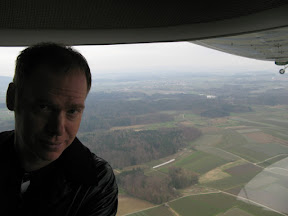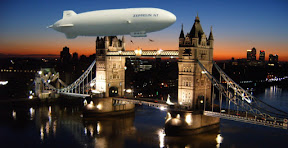AirJelly An airborne jellyfish with electric drive unit Info Glides through the air by peristaltic motion A central electric drive unit with crank mechanism Can the jellyfish’s motion through water serve as a propulsion principle for an airborne object? In other words, is it possible to glide through the air as a jellyfish swims through water? These were the considerations that gave rise to the development of AirJelly. The history of aviation has been aware of the analogy between the media of water and air ever since the first gas balloon flights of Jacques Alexandre César Charles, who on 1st December 1783 set off from Paris on the first ever manned gas balloon journey together with Noel Robert. The gondola of the “Charlière” was designed in the form of a ship’s hull. The balloon of the French aviator Jean Pierre François Blanchard, who crossed the English Channel from Dover to Calais together with Dr. John Jeffries on 7 th January 1785, also used a gondola in the form of a ship’s hull. It is therefore all the more surprising that this analogy from a bygone era has not provided inspiration for adapting the propulsion mechanisms of marine creatures for drive units in the aviation sector. In 2005, the Swiss Materials Science & Technology Development (EMPA) in Dübendorf near Zurich presented a concept in which the balloon of an airship was to be covered with electro-active polymer foils. The airship was to float in the sea of air like a fish in water. This airship has since been fitted with elevators and rudders actuated with electro-active polymer foils. Seeking recourse to jellyfish as a source of inspiration for powering gas-filled balloons is an obvious thought; after all, a jellyfish consists of water to 99%. Its weight-to-volume ratio is approximately 1, and the figure is similar for a gas-filled balloon. Jellyfish fossil finds indicate an ability to survive dating back more than 500 million years. Jellyfish have thus repeatedly adapted to various environmental and living conditions and have become veritable survival artists; the diversity of jellyfish species suggests a high degree of adaptability. AirJelly is a remote radio-controlled airborne jellyfish with a central electric drive unit and an intelligent adaptive mechanism. AirJelly consists of a helium-filled ballonett with a diameter of 1.35 meters. This yields a filling volume of 1.3 cubic meters of helium. Since one cubic meter of helium provides buoyancy to lift approximately one kilogram, the total weight of AirJelly, comprising its ballonett and all ancillary components, must amount to no more than 1.3 kilograms. AirJelly houses two lithium-ion polymer accumulator batteries rated at 8 V and 400 mA, which can be completely charged in half an hour and are AirJelly’s sole source of power. A connected central electric drive unit transmits the force to a bevel gear wheel and 2 then to eight spur gears in sequence. These gears power eight shafts, each of which activates a crank; these in turn move the jellyfish’s eight tentacles. Each tentacle is designed as a structure with Fin Ray Effect ® – a construction derived from the functional anatomy of a fish’s fin. The actual structure consists of two alternating tension and pressure flanks movably connected by ribs. If a flank is subjected to pressure, the geometrical structure automatically bends in the direction of the applied force. Together, the tentacles produce a peristaltic forward motion similar to that of their biological model. Controlling AirJelly’s motion in three-dimensional space is effected by weight displacement. For this purpose, a pendulum is set in motion by two actuators in the X and Y directions. The actuators are positioned at the jellyfish’s “north pole” and are proportionally controlled. The pendulum is 55 centimetres long. AirJelly’s centre of mass is displaced in the direction of the pendulum’s motion; the jellyfish then moves in the same direction. By means of this peristaltic forward motion, AirJelly can move in any spatial direction. Propulsion of a ballonett by means of peristaltic motion is as yet unknown in the history of aviation. AirJelly is thus the first indoor flight object with peristaltic drive. Observation of models from nature gave rise to this new propulsion concept for the airborne jellyfish. With this exhibit, Festo is demonstrating that a central electric drive unit in combination with an intelligent mechanism opens up fascinating opportunities in propulsion systems for lighter-than-air flight. Both in automation and in didactics, Festo sets out to generate enthusiasm among its customers with innovative, fascinating and intelligent solutions; it therefore offers a wide range of electric, pneumatic and hybrid drive units, along with the appropriate sensor systems, control and regulating components. 3 Project partners Project initiator: Dr. Wilfried Stoll, Chairman of the Supervisory Board, Festo AG Project team: Rainer and Günther Mugrauer, Effekt-Technik GmbH, Schlaitdorf, Germany Project manager: Markus Fischer, Corporate Design Festo AG & Co. KG Graphic design: Atelier Frank, Berlin, Germany Technical data Diameter: Height: Total weight: Propulsion: Reduction ratio: Power supply: 1.35 m 2.20 m 1.3 kg coreless motor, 3 V 262:1 lithium-ion polymer accumulator batteries; 8 V and 400 mA Festo AG & Co. KG Corporate Design Rechbergstraße 3 73770 Denkendorf Germany www.festo.com/de/bionic Phone +49/7 11/347-38 80 Fax +49/7 11/347-38 99 fish@de.festo.com Photos: Walter Fogel, Angelbachtal, Germany Brand designation: Fin Ray Effect ® is a brand of Evologics GmbH, Berlin, Germany 52938 EN
Please don't forget to subscribe to Airshipworld if you haven't subscribed yet. You can subscribe to our RSS Feed or via Email. Subscribing is free but it helps us to know how big our audience is and to see how many people are interested in airships.









